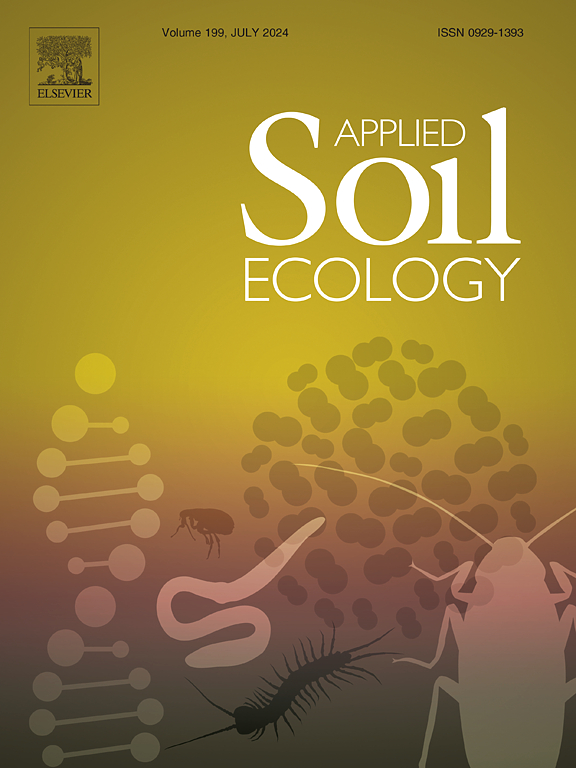Log decomposition and forest gaps synergistically shape the structure and function of wood-inhabiting microbial communities in forest ecosystems
IF 5
2区 农林科学
Q1 SOIL SCIENCE
引用次数: 0
Abstract
Understanding the intricate relationships between microbes, log decomposition, and forest disturbance is vital for conserving microbial diversity and maintaining the health of forest ecosystems. However, the successional dynamics of wood-inhabiting microbial communities across different decay stages and their responses to varying forest gap positions remain poorly understood. Here, we present results from a 6-year in-situ experiment using Minjiang fir (Abies faxoniana) logs across five decay classes (I–V, representing increasing levels of decay) placed in gap centers, gap edges and under a closed canopy on the eastern Tibetan Plateau, China. Using high-throughput sequencing coupled with FUNGuild and Functional Annotation of Prokaryotic Taxa (FAPROTAX) analyses, we identified a total of 6193 fungal and 10,530 bacterial operational taxonomic units (OTUs). Fungal diversity in decaying logs initially increased, peaking in class III (maximum increase: 64 %), before declining in later stages. In contrast, bacterial diversity increased continuously, reaching its highest levels in decay classes IV and V (maximum increase: 27 %). Both fungal and bacterial species richness in decaying logs were greater at the center of forest gaps than under the closed canopy. Highly decayed logs favored specific fungal functional groups, such as ectomycorrhizal and saprotrophic fungi. Bacterial functional groups associated with the carbon cycle peaked in highly decayed logs (class V), whereas those linked to the nitrogen cycle were more abundant under the closed canopy. The dominant phyla, genera, and functional groups of fungi and bacteria were primarily driven by changes in log water content mediated by forest gaps, and the resulting pH and nutrient dynamics, rather than by temperature. These results highlight the pivotal roles of decaying logs and forest gaps in shaping the structural and functional succession of microbial communities. Therefore, maintaining coarse woody debris across various decomposition stages, particularly advanced decay classes, along with moderate gap disturbance, promotes the conservation of wood-inhabiting microbial diversity in forest ecosystems. Our study provides in-depth insights into the positive effects of forest disturbances, which are essential for informing sustainable forest management practices and preserving ecosystem health.

在森林生态系统中,木材分解和林隙共同塑造了栖息在木材中的微生物群落的结构和功能
了解微生物、原木分解和森林扰动之间的复杂关系对于保护微生物多样性和维持森林生态系统的健康至关重要。然而,不同腐烂阶段木材微生物群落的演替动态及其对不同林窗位置的响应尚不清楚。在这里,我们介绍了一项为期6年的原位实验的结果,该实验使用了岷江冷杉(Abies faxoniana)原木,在中国青藏高原东部的林窗中心、林窗边缘和封闭林冠下放置了5个腐烂等级(I-V,代表腐烂程度的增加)。利用高通量测序,结合FUNGuild和原核分类单元功能注释(FAPROTAX)分析,共鉴定出6193个真菌和10530个细菌操作分类单元(otu)。腐烂原木真菌多样性开始增加,在第III类达到峰值(增幅最大达64%),后期呈下降趋势。相比之下,细菌多样性不断增加,在IV和V类腐烂中达到最高水平(最大增幅为27%)。腐木真菌和细菌物种丰富度在林隙中心均高于封闭林冠下。高度腐烂的原木有利于特定的真菌功能群,如外生菌根真菌和腐养真菌。与碳循环相关的细菌官能团在高度腐烂的原木(V类)中达到顶峰,而与氮循环相关的细菌官能团在封闭树冠下更为丰富。真菌和细菌的优势门、属和功能类群主要受林隙介导的原木含水量变化以及由此产生的pH和养分动态的影响,而不是受温度的影响。这些结果强调了腐烂原木和森林间隙在塑造微生物群落结构和功能演替中的关键作用。因此,在不同的分解阶段保持粗木屑,特别是在高级腐烂阶段,以及适度的间隙干扰,可以促进森林生态系统中栖息木材的微生物多样性的保护。我们的研究对森林干扰的积极影响提供了深入的见解,这对可持续森林管理实践和保护生态系统健康至关重要。
本文章由计算机程序翻译,如有差异,请以英文原文为准。
求助全文
约1分钟内获得全文
求助全文
来源期刊

Applied Soil Ecology
农林科学-土壤科学
CiteScore
9.70
自引率
4.20%
发文量
363
审稿时长
5.3 months
期刊介绍:
Applied Soil Ecology addresses the role of soil organisms and their interactions in relation to: sustainability and productivity, nutrient cycling and other soil processes, the maintenance of soil functions, the impact of human activities on soil ecosystems and bio(techno)logical control of soil-inhabiting pests, diseases and weeds.
 求助内容:
求助内容: 应助结果提醒方式:
应助结果提醒方式:


